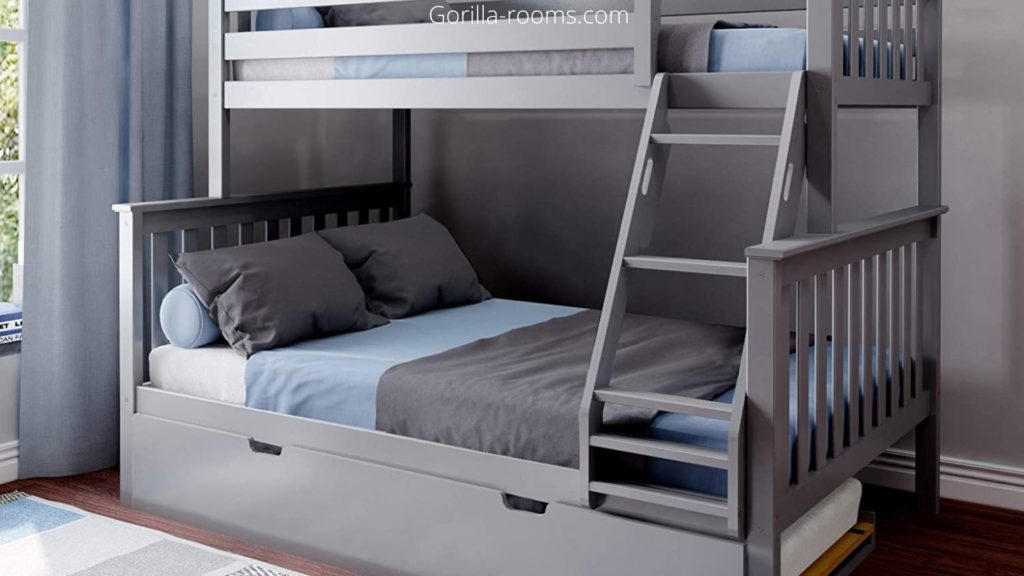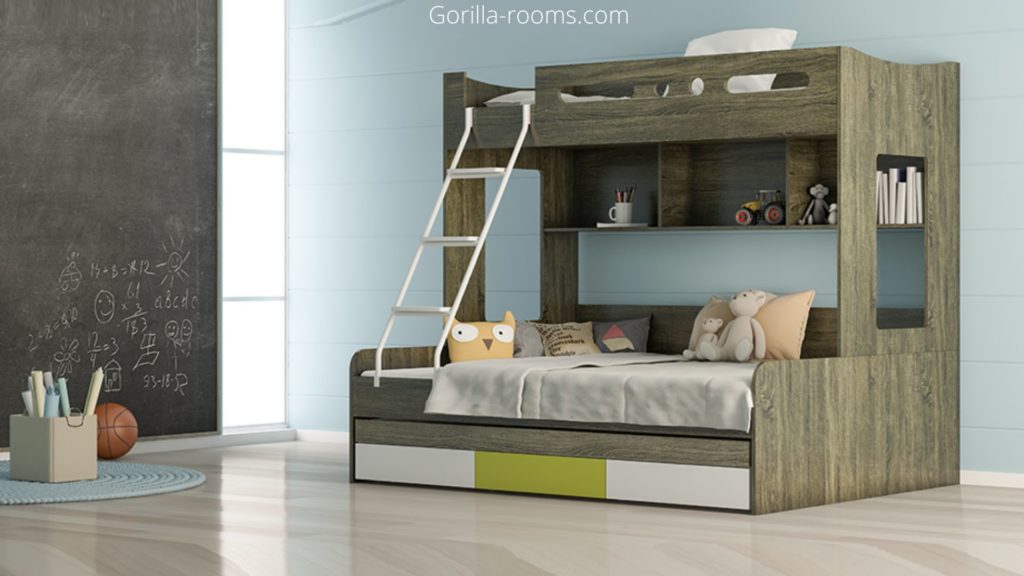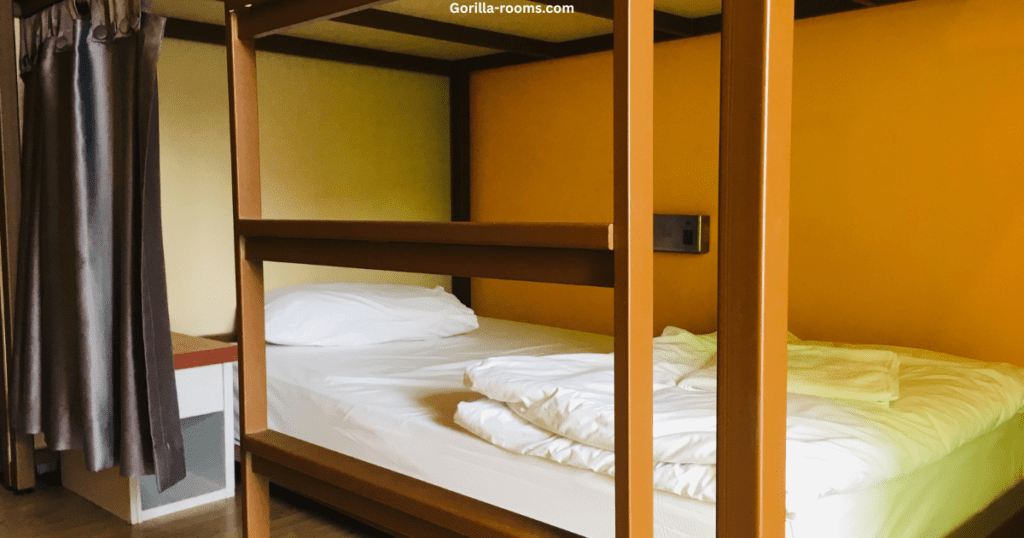A bunk bed ladder is essential; it allows you to reach the top bunk. If the ladder is not strong, it might break and cause injury.
The ladders of the bunk bed have different sizes and widths. The standard width of the bunk bed ladder should be 14-17 inches. But for kids, it’s not sufficient, and their ladder should be 25 – 30 inches wider to provide them extra space.
Ladder width size also depends on factors like the nature of the bunk bed, material, and height. So let’s discuss the exact width of your bunk bed ladder.
How Wide Should a Bunk Bed Ladder Be?

Widths for a bunk bed ladder vary with the types of bunk bed for which ladder is to be used and for which age group a bunk bed is being made?
The average age of children for which bunk beds were made is 6-8 years. However, adults can also use bunk beds between 12-15 years.
The mean Width of a ladder for a standard bed is 14-18 inches. The width of an inclined ladder is approximately 20 inches. On the other hand, commercial bunk bed ladders are usually about 12 inches wide.
However, the width of the ladder for children’s bunk beds should be increased for safety purposes. A ladder in a kid’s bunk bed is typically 30 inches wide.
Dimensions For Width Of Ladder With Types Of Bunk Bed?

- For a Low Loft bed, the average height must be 50.75″, the length must be 80″, and the Width must be 80.5″ to provide more excellent safety and support.
- For a Mid Loft or Low Bunk, the average height is 61.5 inches, Length is 80 inches, and Width is 88.75 inches.
- For a Medium Bunk, the standard Width is 66.25 inches, Length is 80 inches, and the Width must be 89.75 inches.
- Lastly, the High Loft bed must have a height of 71 inches, a length of 80 inches, and a width of 92 inches. The wider the ladder, the more balanced and safe it will be for children.
Making a Ladder for a Bunk Bed!
Bunk beds are now used in almost every apartment for the children. Aside from giving them more space, it also gives them the illusion that they have their own private space.
A ladder is an essential part of the bunk bed because it enables you to go up and down the bed. Making a Ladder for a bunk bed has the following steps:
Step 1: Take into account the Ladder’s Height

Before you begin the construction, measure how long the Ladder should be; because building begins with the cutting of the side railing. So, the Height of the top bunk determines the Ladder’s Height.
You must consider the angle at which the Ladder should be leaned. How much inclined the Ladder should be must be determined!
So, a 15-degree angle is not bad. It seems to be a better angle for making it easy for the children to climb.
Step 2: Making side rails for Ladder
Building a ladder is not such a difficult task; you have to take the correct measurements with respect to the bunk bed.
- The first step is to use a saw to cut two pieces 14 to 62 inches long with a 15-degree angle on each end.
- Next, determine how many steps the Ladder should have and how much space between each of the steps. This also depends on the age group of children for which Ladder is being made.
Because an adult can quickly go through the Ladder with fewer steps, a little kid would have needed more steps to go quickly.
- Consider we go with 5 steps. To determine the space between the steps, multiply 5 times ¾ inches (the thickness of each step). Then remove that figure from the whole length of the rail and divide it by 6. (the number of spaces). This amounted to around 9 3/4′′.
- Cut a 14-inch piece to this length, with one end cut at a 15-degree angle. Then use it as a framework to mark the location of each step.
Once all of the steps are marked on both rails, use a router (set to 1/2′′ depth) to cut out notches inside the step marks to fix the ladder steps. This would be more secure and sturdy than fixing steps with nails separately.
Step 3: Add the Ladder Steps
Using a table saw, cut the piece from 1×6 to 4″ in width. Then cut it into five 15 inch long pieces. When all of the steps are cut, add some wood glue to each notch on both rails.
Then, please insert it into one of the bunk bed ladder rails for each step. On the backside of the Ladder, ensure that the top edge of the steps is perfectly flat with the rails; this will give the Ladder more stability.
Place the other rail, and then secure the steps to the rails with 1 1/4′′ finish nails.
What Size Steps Should The Ladder Have?

Ladder steps to be made for a bunk bed can be vertical and horizontal. The vertical Ladder is less stable and unsafe for kids, so the steps must be wider because the whole strength of the Ladder depends on the steps!
The average distance between the treads should be about 8 to 10 inches (20 to 25 cm), but you can cut more or less according to the length or size of your bunk bed for the comfort of getting up and down the Ladder.
The wide bunk bed steps also provide additional rigidity to the Ladder, preventing slipping from the Ladder and making you safe.
How Should a Bunk Bed Ladder Be Used Properly?
The bunk bed Ladders are frequently used to reach the top bunk. Taking precautions while climbing, on the other hand, is critical.
Because falling from a bunk bed can result in a variety of injuries. So for the sake of your child’s health and to prevent injuries, you should be aware of how to use the Ladder properly.
You should first place your bunk bed in a secure and convenient location to accomplish this. Then, using a ladder or stairs, climb to the top.
The Ideal Method To Use Ladder!
1- To Climb Up To The Top Bunk:
Start by putting one foot on each consecutive tread of the Ladder and working your way up to the top bunk.
Put your hands on the bed as you reach the top. You should be in a crawling position once your feet reach the top of your Ladder. Then all you should do is simply crawl into bed.
2- Climb Down The Ladder:
Swing your feet onto the top rung to return to the floor. Make sure you face the rungs and not climb down in the opposite direction. Then, work your way down the Ladder, one foot at a time.
Move slowly and avoid catching your foot on a rung as you go up or down.
You can also install a light for the climbing ladder at night for your ease, preventing any risk of a fall injury.
Inappropriate Methods For Using a Ladder!
If you are not aware of the proper method for climbing up and down the Ladder, you may sustain various injuries, ranging from severe to fatal.
The following techniques used by kids which can lead them to injury are:
1- Jump to the top bunk:
Jumping from the floor to the top bunk can cause falls, leading to head injuries, even coma, or death. So, jumping to the bunk is not an appropriate method. Educate your child on the exact method to climb.
2- Climbing Over sides:
Some children may also use the side rails instead of steps to reach the top bunk. This also plays a significant role in injuries.
Bunk Bed Ladder Safety Guidelines:
As we all know, falls from bunk beds are most common among younger adults; therefore, you should take preventive measures and adhere to the safety guidelines mentioned below!
- The first step is to ensure that the ladders are correctly and securely attached to the bunk bed frame and that the bed is stable. Confirm that all fittings (bolts, nuts, and screws) are securely fastened and flush with the bed frame.
- Ensure that the mattress foundation or thickness is secure and that a mattress is appropriate for the child’s age group to be used on the bed.
- Children under the age of six should not be allowed to sleep in the upper bunk, and it would be more desperate for them.
- Discourage children from playing on bunk beds, also use night lights to help children see the ladder climbing at night. This will prevent any accidents.
- Remove hazardous objects from around the bed and do not place the bunk bed too close to ceiling fans.
- Bunk beds should not be altered so that safety standards are violated.
- Guardrails should be installed on both sides of the top bunk. To prevent strangulation, guardrail gaps should be 3.5 inches or less.
- Guardrails should reach approximately 5 inches above the mattress level; if youngsters roll off while sleeping, these elevated railings will keep them from falling or injuring themselves.
- If any parts of the bunk bed or Ladder are damaged, do not use them. If used, the Ladder would not handle the load and would break, resulting in a fall.
- As proper ways are indicated above, teach children how to use the Ladder carefully.
- Allow children to use belts, scarves, or ropes to attach to the bunk bed. This can result in strangulation.
FAQ’s
What angle should a bunk bed ladder be?
Bunk bed Ladders can be attached to the bed in many ways, such as: Straight, Angled.
Another option is to use Stairs instead of using a ladder for safety concerns.
For a more upright ladder staircase, the standard angle that experts create is a 15-degree floor angle.
At one end of each 2 x 4 piece of lumber, mark the angle on the wide side. Make the cut with care using the saw you’ve chosen.
How far should a bunk bed be from the ceiling?
The space between the top bunk bed and the ceiling must be at least two feet to avoid bumps. While the heights of bunk beds vary, the average bunk is between 5 1/2 and 6 feet tall, so you should build or buy the bunk bed based on the Height of your room.
Standard ceilings are typically around 8 inches to 9 inches tall. Below 8 inches is considered low, and above 9′ is considered high, so a bunk bed height must be kept below them.
How far should a bunk bed be from the ceiling?
The space between the top bunk bed and the ceiling must be at least two feet to avoid bumps. While the heights of bunk beds vary, the average bunk is between 5 1/2 and 6 feet tall, so you should build or buy the bunk bed based on the Height of your room.
Do bunk beds need an exceptional mattress?
A bunk bed necessitates a thinner profile mattress; choose one of higher quality that will not begin to break down or sag.
A high-quality mattress will have a dense base foam that can support any sleeper and last for years.
Numerous foams on the market, ranging from latex to memory foam, depending on your satisfaction and fabric preferences.
Do bunk beds need an exceptional mattress?
A bunk bed necessitates a thinner profile mattress; choose one of higher quality that will not begin to break down or sag.
A high-quality mattress will have a dense base foam that can support any sleeper and last for years.
What’s the size of a bunk bed?
A Regular, Single, or Twin bunk bed is 75-inch x 39-inch x 65 inches.
A large or Double bunk bed is 75 in. x 54 in. x 65 in.
Bunk beds usually come in various sizes, including small bunk beds, triple bunk beds, and bunk beds with plods. Queen and King size bunk beds are uncommon.
Can you move a ladder on a bunk bed?
Yes, you can move a bunk bed ladder and position it according to your need and feasibility.
You can move it from the foot side to the head side and vice versa.
How much weight can a bunk bed ladder hold?
The maximum weight capacity of a bunk bed is usually explicitly specified. Top bunks can support between 150 pounds and 450 pounds depending on the quality and manufacturing.
A bunk bed can usually hold 200 to 260 pounds if it’s intended for a twin mattress.
Conclusion:
As from the above discussion, it is known that bunk beds are available in the market with many benefits, and the Ladder to be used for your bunk bed falls under the scope of safety concerns required for children if you build or buy an excellent Ladder for your bunk bed.
Related Posts:
Replace Bed Slats With Plywood
16 Amazing Emerald Green Bedding Ideas

